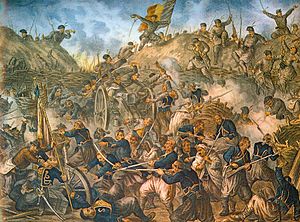
Back حصار بلفن Arabic Plevnanın mühasirəsi Azerbaijani Обсада на Плевен Bulgarian Setge de Plevna Catalan Obléhání Plevna Czech Schlacht von Plewna German Sitio de Pleven Spanish Plevnan piiritys Finnish Siège de Plevna French Plevna ostroma Hungarian
This article has multiple issues. Please help improve it or discuss these issues on the talk page. (Learn how and when to remove these template messages)
|
| Siege of Pleven | |||||||
|---|---|---|---|---|---|---|---|
| Part of the Russo-Turkish War (1877–1878) | |||||||
 The capture of the Grivitsa redoubt, by Henryk Dembitzky | |||||||
| |||||||
| Belligerents | |||||||
|
|
| ||||||
| Commanders and leaders | |||||||
|
(1st Rus. assault)[5] (2nd Rus. assault)[5] (Great Assault)[a][5] (Great Assault)[b][5] (Great Assault)[5] (Breakout attempt)[5] (Breakout attempt)[5] (Great Assault)[c][5] |
Sefë Kosharja Abdullah Pashë Dreni | ||||||
| Strength | |||||||
|
130,000[2] |
67,000[2] | ||||||
| Casualties and losses | |||||||
|
50,000 killed, wounded and missing[1] |
25,000 killed or wounded[1] | ||||||

The siege of Plevna or Pleven, was a major battle of the Russo-Turkish War of 1877–1878, fought by the joint army of Russian Empire and Kingdom of Romania against the Ottoman Empire.[6] After the Russian army crossed the Danube at Svishtov, it began advancing towards the centre of modern Bulgaria, with the aim of crossing the Balkan Mountains to Constantinople, avoiding the fortified Turkish fortresses on the Black Sea coast. The Ottoman army led by Osman Pasha, returning from Serbia after a conflict with that country, was massed in the fortified city of Pleven, a city surrounded by numerous redoubts, located at an important road intersection.
After two unsuccessful assaults, in which he lost valuable troops, the commander of the Russian troops on the Balkan front, Grand Duke Nicholas of Russia insisted by telegram on the help of his Romanian ally King Carol I. King Carol I crossed the Danube with the Romanian Army and was placed in command of the Russian-Romanian troops. He decided not to make any more assaults, but to besiege the city, cutting off the food and ammunition supply routes.
At the beginning of the siege, the Russian-Romanian army managed to conquer several redoubts around Pleven, keeping in the long run only the Grivitsa redoubt. The siege, which began in July 1877, did not end until December of the same year, when Osman Pasha tried unsuccessfully to force the siege to break and was wounded. Finally, Osman Pasha received the delegation led by General Mihail Cerchez and accepted the conditions of capitulation offered by him. The Turkish general, Osman Pasha, when he capitulated and declared himself a prisoner during the Russo-Turkish War, handed over his sword to the Romanian general Mihail Cerchez, commander of the Romanian troops in Pleven. It was housed in the Museum of the Iron Gates Region, but was stolen in 1992.
The Russian–Romanian victory on 10 December 1877 was decisive for the outcome of the war and the Liberation of Bulgaria. Following the battle, the Russian armies were able to advance and forcefully attack the Shipka Pass, succeeding in defeating the Ottoman defense and opening their way to Constantinople.
- ^ a b c d e f g h i j k l m n o p q r s t u v w x y z aa ab ac Clodfelter, Micheal (2002). Warfare and Armed Conflicts: A Statistical Reference to Casualty and Other Figures, 1500–2000 (2nd ed.). Jefferson, N.C.: McFarland. p. 220. ISBN 0-7864-1204-6. OCLC 48003215.
- ^ a b c Panthaki, Neville G. (2002). "Pleven/Plevna, Siege of (20 July–10 December 1877)". In Sandler, Stanley (ed.). Ground warfare: an international encyclopedia. Santa Barbara, Calif.: ABC-CLIO. p. 690. ISBN 1-57607-733-0. OCLC 52521652.
- ^ AJP Taylor (1963). The Struggle for Mastery in Europe: 1848–1918. p. 245.
- ^ Drury, Ian (1994). The Russo-Turkish War 1877: Men-at-Arms. London: Osprey. p. 6. ISBN 1-85532-371-0. OCLC 34911468.
- ^ a b c d e f g h Azyassky 2023.
- ^ Crowe, John Henry Verinder (1911). . In Chisholm, Hugh (ed.). Encyclopædia Britannica. Vol. 21 (11th ed.). Cambridge University Press. pp. 838–840, see page 838.
Battles of 1877....
Cite error: There are <ref group=lower-alpha> tags or {{efn}} templates on this page, but the references will not show without a {{reflist|group=lower-alpha}} template or {{notelist}} template (see the help page).
© MMXXIII Rich X Search. We shall prevail. All rights reserved. Rich X Search